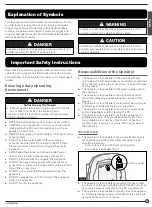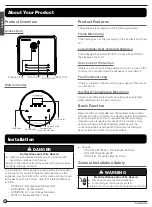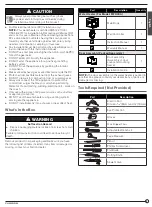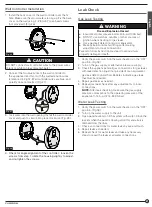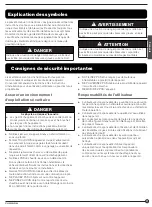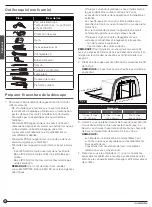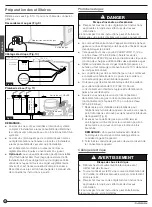
10
English
Wall Controller Installation
1. Install the back cover of the wall controller over the 3/4”
hole. Make sure the arrow mark is facing up. Fix the back
cover on the wall using 2 - #8 (min 1") pan head screws
(not provided). (Fig. 26)
Fig. 26
CAUTION
DO NOT connect wall controller wires to the power wires
(black or white) on rear of water heater.
2. Connect the two blue wires of the wall controller to
the appliance directly or with the wall extension wires
referenced in Fig 12. (Wall controller wires are blue, and
polarity does not matter.)(Fig. 27)
Fig. 27
3. Tuck wires into the wall opening. Install the wall controller
cover and push to secure into place clockwise. (Fig. 28).
Fig. 28
4. Check for angle alignment of the controller: loosen the
screws from step 1, rotate the housing slightly to adjust,
and re-tighten the screws.
Leak Check
Gas Leak Testing
WARNING
Fire and Explosion Hazard
●
Ensure test pressures are below 40in-wc (100mbar).
●
DO NOT use matches, candles or other sources of
ignition when checking for gas leaks.
●
Use a gas leak detection liquid or equivalent.
●
Make certain to re-test all fittings after making
adjustments to loose connections.
Failure to follow instruction may lead to serious injury,
property damage or death.
1. Verify the power switch on the water heater is in the “OFF”
position. (Fig. 18)
2. Turn on the gas supply or alternative pressure supply.
3. Check the appliance and all gas connections for gas leaks
with leak detection liquid (not provided) or an equivalent
gas leak detection method. Bubbles indicate a gas leak
that must be repaired.
4. Repair gas leaks as needed.
5. Repeat gas leak check after any adjustments to loose
connections.
NOTE:
After leak checking, make sure the gas supply
pressure corresponds to the operating pressure of the
appliance 11~14in-wc (27.4~34.9mbar).
Water Leak Testing
1. Verify the power switch on the water heater is in the “OFF”
position .(Fig. 18)
2. Turn on the water supply to the unit
3. Open water faucets to fill the system with water. Close the
faucets when the water is flowing smoothly and all air is
removed from the lines.
4. Check all connections for water leaks by eye and touch.
5. Repair leaks as needed.
6. Repeat check for water leaks and take any necessary
steps to repair the leaks at all water connections.



